
The AGM-65 Maverick is an air-to-ground missile (AGM) designed for close air support. It is the most widely produced precision-guided missile in the Western world, and is effective against a wide range of tactical targets, including armor, air defenses, ships, ground transportation and fuel storage facilities.
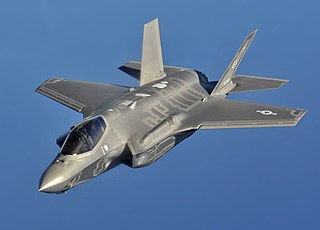
The Lockheed Martin F-35 Lightning II is an American family of single-seat, single-engine, all-weather stealth multirole combat aircraft that is intended to perform both air superiority and strike missions. It is also able to provide electronic warfare and intelligence, surveillance, and reconnaissance capabilities. Lockheed Martin is the prime F-35 contractor, with principal partners Northrop Grumman and BAE Systems. The aircraft has three main variants: the conventional takeoff and landing (CTOL) F-35A, the short take-off and vertical-landing (STOVL) F-35B, and the carrier-based (CV/CATOBAR) F-35C.
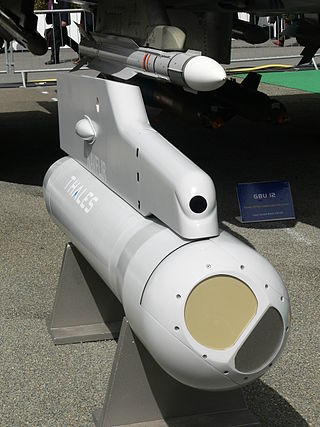
Forward-looking infrared (FLIR) cameras, typically used on military and civilian aircraft, use a thermographic camera that senses infrared radiation.

An air-to-air missile (AAM) is a missile fired from an aircraft for the purpose of destroying another aircraft. AAMs are typically powered by one or more rocket motors, usually solid fueled but sometimes liquid fueled. Ramjet engines, as used on the Meteor, are emerging as propulsion that will enable future medium-range missiles to maintain higher average speed across their engagement envelope.

Stealth aircraft are designed to avoid detection using a variety of technologies that reduce reflection/emission of radar, infrared, visible light, radio frequency (RF) spectrum, and audio, collectively known as stealth technology. The F-117 Nighthawk was the first operational aircraft specifically designed around stealth technology. Other examples of stealth aircraft include the B-2 Spirit, the B-21 Raider, the F-22 Raptor, the F-35 Lightning II, the Chengdu J-20, and the Sukhoi Su-57.

Shtora-1 is an electro-optical active protection system or suite for tanks, designed to disrupt the laser designator and laser rangefinders of incoming anti-tank guided missiles (ATGMs). The system is mounted on the Russian T-80 and T-90 series tanks and the Ukrainian T-84. The existence of Shtora was revealed in 1980 by Adolf Tolkachev.

The Lockheed Martin Sniper is a targeting pod for military aircraft that provides positive target identification, autonomous tracking, GPS coordinate generation, and precise weapons guidance from extended standoff ranges.

Fire-and-forget is a type of missile guidance which does not require further external intervention after launch such as illumination of the target or wire guidance, and can hit its target without the launcher being in line-of-sight of the target. This is an important property for a guided weapon to have, since a person or vehicle that lingers near the target to guide the missile is vulnerable to attack and unable to carry out other tasks.

RAPTOR was a reconnaissance pod used by the Royal Air Force on its fleet of Tornado GR.4A and GR.4 aircraft. RAPTOR was manufactured by the Goodrich Corporation, initially part of UTC Aerospace Systems, but now part of Collins Aerospace.

Targeting pods (TGP) are target designation tools used by attack aircraft for identifying targets and guiding precision-guided munition (PGM) such as laser-guided bombs to those targets. The first targeting pods were developed in conjunction with the earliest generation of PGMs in the mid-1960s.
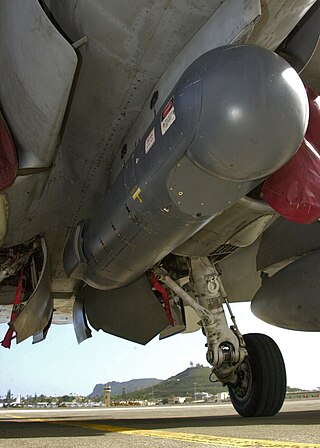
The AN/AAQ-28(V) Litening targeting pod is an advanced precision targeting pod system currently operational with a wide variety of aircraft worldwide. The research and development of the Litening was first undertaken by Rafael Advanced Defense Systems' Missiles Division in Israel, with subsequent completion of Litening I for use in the Israeli Air Force.

An infrared search and track (IRST) system is a method for detecting and tracking objects which give off infrared radiation, such as the infrared signatures of jet aircraft and helicopters.
Electro-optical MASINT is a subdiscipline of Measurement and Signature Intelligence, (MASINT) and refers to intelligence gathering activities which bring together disparate elements that do not fit within the definitions of Signals Intelligence (SIGINT), Imagery Intelligence (IMINT), or Human Intelligence (HUMINT).

The Agency for Defense Development (ADD) is the South Korean national agency for research and development in defense technology, funded by the Defense Acquisition Program Administration (DAPA). It was established in August 1970 under the banner of the self-reliable defense. Its purpose is contributing to enforcing the national defence, to improving the national R&D capacity, and to fostering the domestic defense industry. ADD focuses on core weapons systems and core technology development, and studies major weapons platforms in high-risk and non-economical fields, unmanned and advanced, and new weapon systems for the future.
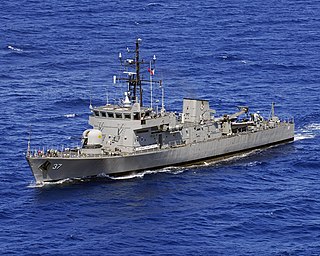
The Jacinto-class patrol vessels currently in service with the Philippine Navy are three ships formerly belonging to the Royal Navy's Hong Kong Squadron as Peacock-class corvettes until 1997. The ships have undergone combat, electronics, weapon, propulsion and hull upgrades, with the most recent upgrade completed in August 2019. These increased their capabilities compared to the original Peacock-class vessels.
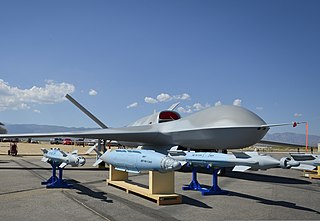
The General Atomics MQ-20 Avenger is a developmental unmanned combat aerial vehicle built by General Atomics Aeronautical Systems for the U.S. military.

The AN/AAQ-37 Electro-optical Distributed Aperture System (DAS) is the first of a new generation of sensor systems being fielded on the Lockheed Martin F-35 Lightning II Joint Strike Fighter. DAS consists of six high-resolution infrared sensors mounted around the F-35's airframe in such a way as to provide unobstructed spherical coverage and functions around the aircraft without any pilot input or aiming required.
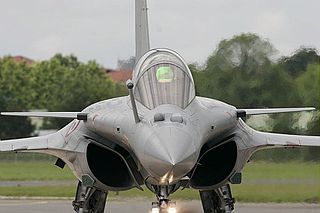
An electro-optical targeting system (EOTS), is a system employed to track and locate targets in aerial warfare. It can use charge-coupled device TV cameras, laser rangefinders and laser designators.

The Defense Acquisition Program Administration (DAPA) was founded on January 1, 2006 as part of a comprehensive reform of the defense acquisition project, including the introduction and development of weapons, and is a central administrative agency of the South Korean Ministry of National Defense.
















